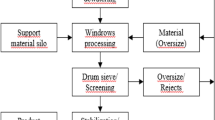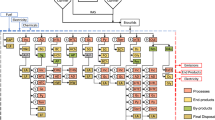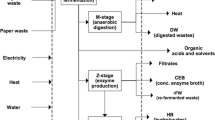Abstract
Management of biosolids from industrial and municipal wastewater facilities presents multifaceted issues ranging from greenhouse gas emissions, high odor and high treatment costs. Until now, most studies that have focused on identifying the best treatment pathway are based on optimization of technological alternatives and life cycle analysis studies. Such studies aim toward sustainability but ignore the capacity of local ecological systems to provide ecosystem services, thus leading to design solutions that may be sub-optimal due to shifting of impacts outside the boundary, resulting in degradation. This work uses a techno-ecological synergy design methodology to identify optimal strategies for biosolids treatment and disposal, by balancing the supply and demand for carbon sequestration ecosystem service. Both the technological systems that create the ecosystem service demand and ecological systems that supply those services are included within one design framework. Technological alternatives for biosolids management in Central Ohio considered in this work are land filling, land application, incineration and composting. Approaches for supplying the carbon sequestration capacity include forestation, extension of timber cycles and geological sequestration. An additional case where biomass utilization from extension of timber cycle to produce renewable energy is also explored. Results from this study demonstrate that including carbon sequestration ecosystem service explicitly in the design problem leads to solutions where the ecosystem service demand and supply can be balanced, while also being cost-effective. Thus by including ecological systems in the design boundary, the optimal solution space expands to reveal novel solutions that cannot be found by the conventional techno-centric approach.





Similar content being viewed by others
Abbreviations
- LCA:
-
Life cycle assessment
- ORWARE:
-
Organic waste research
- TES:
-
Techno-ecological synergy
- \(\bar{A}\) :
-
Flow capacity for arc
- C :
-
Unit processing cost for node in carbon network
- D :
-
Ecosystem service demand
- E :
-
Sets of arcs
- i :
-
Index for arcs or nodes
- j :
-
Index for arcs or nodes
- k :
-
Ecosystem service
- K :
-
Amount of input flow to network
- l :
-
Index for arcs or nodes
- m :
-
Number of arcs
- n :
-
Number of nodes
- \(\bar{N}\) :
-
Flow capacity of node
- N :
-
Sets of nodes
- \(N^\mathrm{{fm}}\) :
-
Set of fixed merging nodes
- \(N^\mathrm{{fs}}\) :
-
Set of fixed splitting nodes
- \(N^{\mathrm{I}}\) :
-
Set of input nodes
- P :
-
Unit processing cost for node in process network
- \(r^{\mathrm{I}}\) :
-
Input flow merging ratio
- \(r^{\mathrm{O}}\) :
-
Output flow splitting ratio
- \(R_{i}\) :
-
Gain or loss ratio for nodes
- S :
-
Ecosystem service supply
- T :
-
Unit transportation cost of arcs
- V :
-
Sustainability index
- x :
-
Amount of flow sent through an arc
References
Ashton S, Baker S, Jackson B, Schroeder R (2007) Conventional biomass harvesting systems. In: Hubbard W, Biles L, Mayfield C, Ashton S (eds) Sustainable forestry for bioenergy and bio-based products: trainers curriculum notebook. Southern Forest Research Partnership Inc, Athens
Bakshi BR, Ziv G, Lepech MD (2015) Techno-ecological synergy: a framework for sustainable engineering. Environ Sci Technol 49(3):1752–1760
Bettinger P, Boston K, Siry JP, Grebner DL (2010) Forest management and planning. Academic Press, New York
Brown S, Leonard P (2004) Building carbon credits with biosolids recycling. BioCycle 45(9):25–29
Brown S, Beecher N, Carpenter A (2010) Calculator tool for determining greenhouse gas emissions for biosolids processing and end use. Environ Sci Technol 44(24):9509–9515
Campbell H (2000) Sludge management-future issues and trends. Water Sci Technol 41(8):1–8
Chen C, Rubin ES (2009) \({\text {CO}}_2\) control technology effects on IGCC plant performance and cost. Energy Policy 37(3):915–924
TSS Consultants (2013) Gasification bioenergy projects: impacts and benefits to air quality. http://ucanr.edu/sites/swet/files/176214.pdf
Crohn DM, Thomas AC (1998) Mixed-integer programming approach for designing land application systems at a regional scale. J Environ Eng 124(2):170–177
Dalemo M, Sonesson U, Björklund A, Mingarini K, Frostell B, Jönsson H, Nybrant T, Sundqvist J, Thyselius L (1997) Orware—a simulation model for organic waste handling systems. Part 1: model description. Resour Conserv Recycl 21(1):17–37
Gabriel S, Sahakij P, Ramirez M, Peot C (2007) A multiobjective optimization model for processing and distributing biosolids to reuse fields. J Oper Res Soc 58(7):850–864
Goedkoop M, Oele M, de Schryver A, Vieira M (2008) Simapro database manual methods library. PRé Consultants, The Netherlands
Gopalakrishnan V, Bakshi BR, Ziv G (2016) Assessing the capacity of local ecosystems to meet industrial demand for ecosystem services. AIChE J 62(9):3319–3333
Hanes RJ, Gopalakrishnan V, Bakshi BR (2017) Synergies and trade-offs in renewable energy landscapes: balancing energy production with economics and ecosystem services. Appl Energy 199:25–44
Hayes SW, Keegan CE, Morgan TA (2011) Estimating harvesting costs. Bureau of Business and Economic Research, The University of Montana. http://www.bber.umt.edu/pubs/forest/prices/loggingCostPoster2011.pdf
Houillon G, Jolliet O (2005) Life cycle assessment of processes for the treatment of wastewater urban sludge: energy and global warming analysis. J Clean Prod 13(3):287–299
Klemes J, Bulatov I, Cockerill T (2005) Techno-economic modelling and cost functions of \({\text {CO}}_2\) capture processes. Comput Aided Chem Eng 20:295–300
Lundin M, Olofsson M, Pettersson G, Zetterlund H (2004) Environmental and economic assessment of sewage sludge handling options. Resour Conserv Recycl 41(4):255–278
Mavrotas G (2009) Effective implementation of the \(\varepsilon\)-constraint method in multi-objective mathematical programming problems. Appl Math Comput 213(2):455–465
Mitchell G, Beasley JE (2011) Optimisation of sludge treatment and transport. J Oper Res Soc 62(6):939–948
Murray A, Horvath A, Nelson KL (2008) Hybrid life-cycle environmental and cost inventory of sewage sludge treatment and end-use scenarios: a case study from China. Environ Sci Technol 42(9):3163–3169
Nielsen ASE, Plantinga AJ, Alig RJ et al (2014) New cost estimates for carbon sequestration through afforestation in the united states. US Department of Agriculture, Forest Service, Pacific Northwest Research Station
Peters GM, Rowley HV (2009) Environmental comparison of biosolids management systems using life cycle assessment. Environ Sci Technol 43(8):2674–2679
Peters GM, Lundie S (2001) Life-cycle assessment of biosolids processing options. J Ind Ecol 5(2):103–121
Rebitzer G, Hunkeler D, Jolliet O (2003) Lccthe economic pillar of sustainability: methodology and application to wastewater treatment. Environ Prog 22(4):241–249
Remy C, Lesjean B, Waschnewski J (2012) Identifying energy and carbon footprint optimization potentials of a sludge treatment line with life cycle assessment. Water Sci Technol 67(1):63–73
Sablayrolles C, Gabrielle B, Montrejaud-Vignoles M (2010) Life cycle assessment of biosolids land application and evaluation of the factors impacting human toxicity through plant uptake. J Ind Ecol 14(2):231–241
Sahakij P, Gabriel SA, Ramirez M, Peot C (2011) Multi-objective optimization models for distributing biosolids to reuse fields: a case study for the blue plains wastewater treatment plant. Netw Spat Econ 11(1):1–22
Sikdar KJ (2008) Material flow optimization and systems analysis for biosolids management: a study of the city of columbus municipal operations. Dissertation. The Ohio State University
Sohngen B, Brown S (2008) Extending timber rotations: carbon and cost implications. Clim Policy 8(5):435–451
Sokhansanj S (2011) Biomass energy data book. http://cta.ornl.gov/bedb
Sonesson U, Dalemo M, Mingarini K, Jönsson H (1997) Orware—a simulation model for organic waste handling systems. Part 2: case study and simulation results. Resour Conserv Recycl 21(1):39–54
Suh YJ, Rousseaux P (2002) An lca of alternative wastewater sludge treatment scenarios. Resour Conserv Recycl 35(3):191–200
Tallaksen J, Kildegaard A (2010) Biomass gasification project biomass gasification: a comprehensive demonstration of a community—scale biomass energy system. USDA final report
Tarantini M, Buttol P, Maiorino L (2007) An environmental LCA of alternative scenarios of urban sewage sludge treatment and disposal. Therm Sci 11(3):153–164
United States Forest Service (2014) Forest inventory and analysis national program. http://www.fia.fs.fed.us/tools-data/. Accessed 26 Feb 2015
Urban RA, Bakshi BR (2013) Techno-ecological synergy as a path toward sustainability of a north american residential system. Environ Sci Technol 47(4):1985–1993
Vadenbo C, Guillén-Gosálbez G, Saner D, Hellweg S (2014a) Multi-objective optimization of waste and resource management in industrial networks—part II: model application to the treatment of sewage sludge. Resour Conserv Recycl 89:41–51
Vadenbo C, Hellweg S, Guillén-Gosálbez G (2014b) Multi-objective optimization of waste and resource management in industrial networks—part I: model description. Resour Conserv Recycl 89:52–63
Wang H, Brown SL, Magesan GN, Slade AH, Quintern M, Clinton PW, Payn TW (2008) Technological options for the management of biosolids. Environ Sci Pollut Res Int 15(4):308–317
Acknowledgements
Partial financial support for this work was provided by the National Science Foundation (CBET-1336872).
Author information
Authors and Affiliations
Corresponding author
Rights and permissions
About this article
Cite this article
Gopalakrishnan, V., Grubb, G.F. & Bakshi, B.R. Biosolids management with net-zero CO2 emissions: a techno-ecological synergy design. Clean Techn Environ Policy 19, 2099–2111 (2017). https://doi.org/10.1007/s10098-017-1398-x
Received:
Accepted:
Published:
Issue Date:
DOI: https://doi.org/10.1007/s10098-017-1398-x




